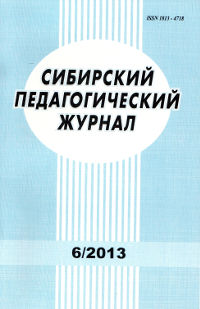THE CHOICE OF THE DOMINANT IDEA OF A TRANSLATION, AS A MANIFESTATION OF THE INDIVIDUAL AND PSYCHOLOGICAL CHARACTERISTICS OF THE INTERPRETER
1. Barkhudarov, L. S., 1975. Language and translation. Mosсow: International Relations Publ., 240 p. (In Russ.)
2. Beresneva, N. I., Dubrovskaya, L. A., Ovchinnikova, L. G., 1995. Associations of children from six to ten years old (associative meaning of the word in ontogenesis). Perm, 128 p. (In Russ.)
3. Bolshunova, N. Ya., 1980. The ratio of signaling systems and individual features of the regulation of cognitive and sensorimotor actions. Questions of psychology, 5, pp. 121–126. (In Russ.)
4. Borisova, M. N., 1956. Method of determining the ratio of the first and second signaling systems. Typological features of higher nervous activity of a man. Moscow: Academy of Pedagogical Sciences of the RSFSR Publ., pp. 307–332. (In Russ.)
5. Vorobyova, T. I., 2015. Formation of professional competencies in the process of learning a foreign language in a technical college. Siberian Pedagogical Journal, 1, pp. 57–61. (In Russ., abstract in Eng.)
6. Demina, E. V., 2009. Individual and psychological features of human abilities. Cand. Sci. (Psychol.). Novosibirsk: NSPU Publ., 29 p. (In Russ.)
7. Dyachkov, A. V., 2018. Individual and typological peculiarities of translating activity as a manifestation of language abilities (based on English language). Moscow: RUDN Publ., 24 p. (In Russ.)
8. Ildutova, O. N., 2014. Teaching of scientific and professional speech in a foreign language for students of physical specialties. Siberian Pedagogical Journal, 3, pp. 130–133. (In Russ., abstract in Eng.)
9. Kabardov, M. K., 2001. Communicative and cognitive components of language abilities (Individual and typological approach). Moscow, 52 p. (In Russ.)
10. Komissarov, V. N., 1990. Theory of Translation (linguistic aspects). Moskow: Higher School Publ., 253 p. (In Russ.)
11. Moskvina, O. V., 2015. Modern technology of teaching a foreign language in the Japanese school. Siberian Pedagogical Journal, 6, pp. 163–167. (In Russ., abstract in Eng.)
12. Pavlov, I. P., 1951–1952. Full composition of writings. In 6 vols., Moscow–Leningrad: Academy of Sciences of the USSR Publ., Vol. 3, part 2, 439 p. (In Russ.)
13. Popelysheva, E. V., Puzakov, A. V., 2010. The essence of the notion of «dominant of translation». Hermes: scientific scholar. Sat: issue. Saransk: Mordov. University Publ., pp. 60–63. (In Russ., abstract in Eng.)
14. Retzker, Ya. I., 1950. On natural correspondences in the translation into the native language. Questions of the theory of the methodology of educational translation. Moscow: Academy of Pedagogical Sciences of the RSFSR Publ., pp. 156–183. (In Russ.)
15. Torop, P., 1995. Total translation. Tartu: Scientific search Publ, 256 p. (In Russ.)
16. Trachenko, O. P., 1998. Cognitive abilities of people depending on the type of hemispheric dominance. 1st International Memory Conference of A. S. Luria. Moscow: RPO Publ., pp. 114–117. (In Russ.)
17. Chomsky, N., 1972. Aspects of the theory of syntax: transl. Moscow: Moscow State University Publ., 260 p. (In Russ.)
18. Newmark, P., 1981. Approaches to Translation. Oxford: Oxford University Press Publ., 352 p. (In Eng.)




